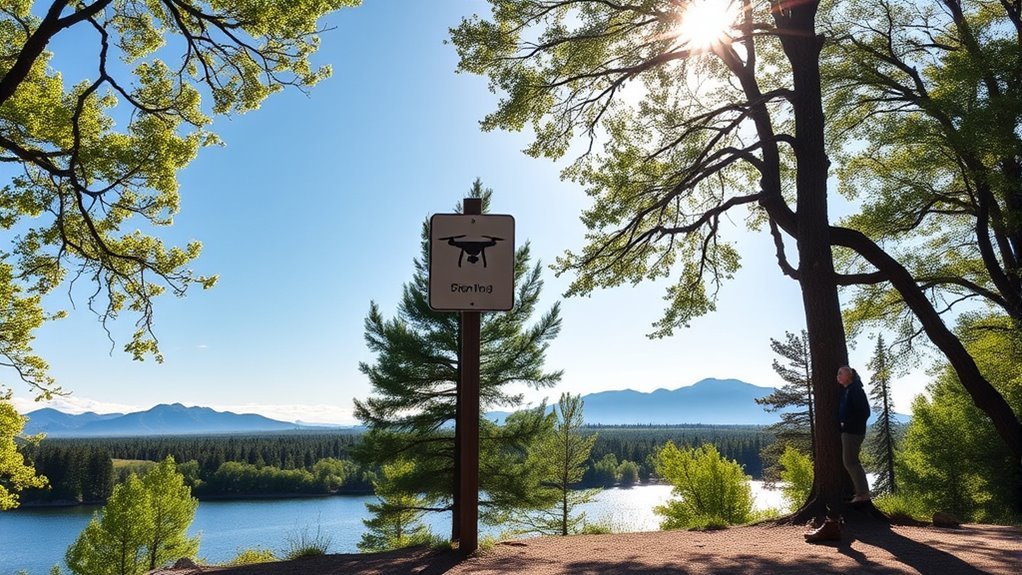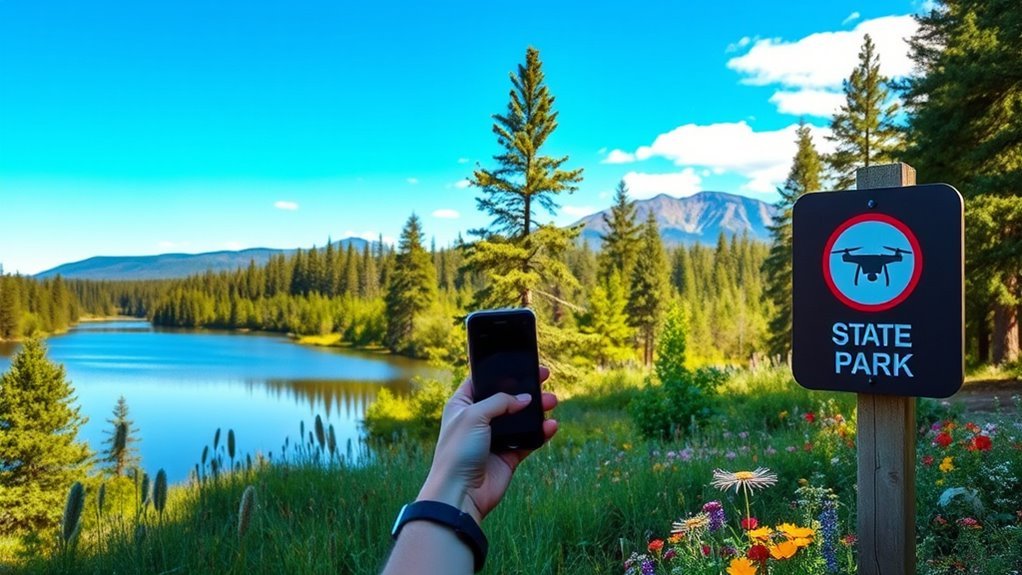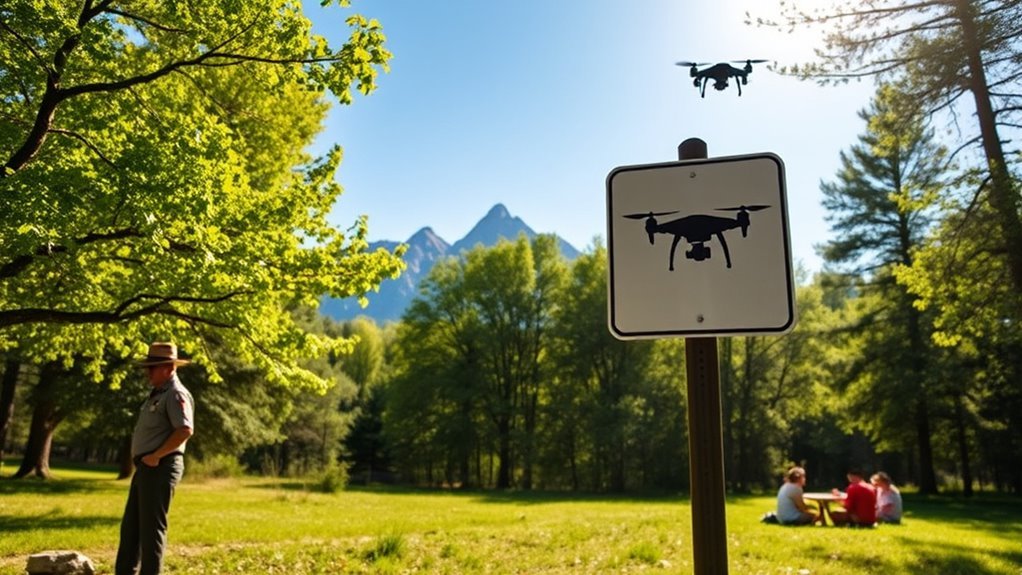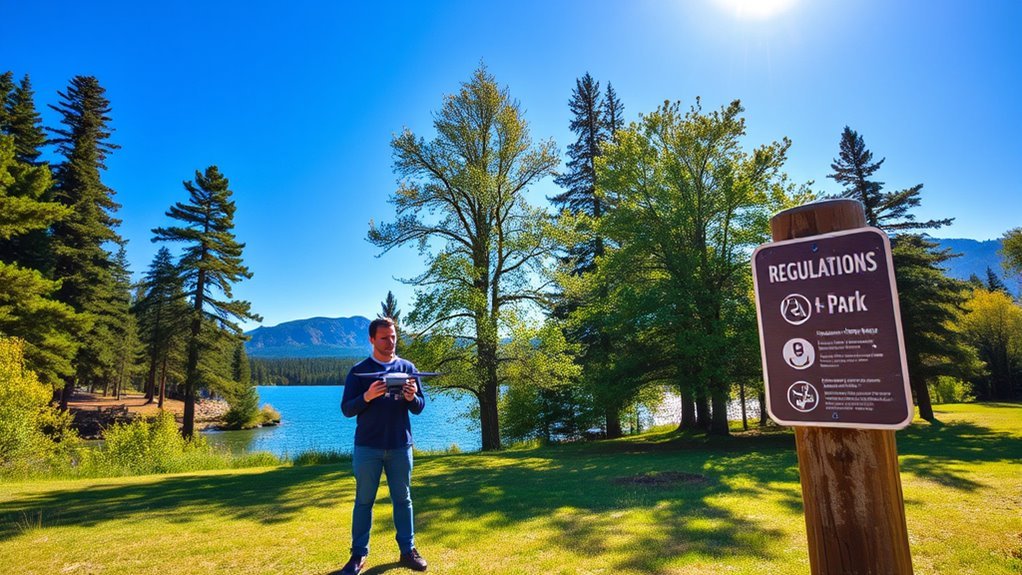To determine if drones are allowed in state parks, check the specific regulations on the park’s official website. Don’t forget to contact park officials for clarification on any questions you have. It’s also crucial to review local and state laws, as these can vary. Look for designated drone zones and be aware of no-fly areas to guarantee compliance. Understanding these guidelines will enhance your drone experience, and there’s more essential information to explore.
Understanding Drone Regulations in State Parks

While drone usage can enhance your outdoor experience, understanding the regulations governing their use in state parks is vital. Each park has specific laws to guarantee drone safety and protect the natural environment. You’ve got to be aware of designated flying zones, altitude limits, and any no-fly areas, such as near wildlife habitats or heavily trafficked areas. Practicing good park etiquette is important; respect the tranquility of other visitors, and avoid disturbing wildlife. Additionally, maintaining visual line of sight with your drone is crucial for safe navigation and immediate response to emergencies. Keep your drone in sight, and always be prepared to land it if necessary. Familiarizing yourself with these regulations before taking off not only enhances your freedom but also guarantees a responsible and enjoyable experience for everyone in the park. Additionally, be mindful of no-fly zones to ensure you are not inadvertently violating any local drone regulations.
Check State Park Websites for Drone Policies

How can you guarantee you’re flying your drone legally in state parks? The first step is to check the official state park websites for their specific drone policies. Each park may have different regulations, and staying informed is key to ensuring drone safety. Look for sections dedicated to park etiquette; they often outline where drones are allowed and any restrictions in place. Some parks may prohibit drone use altogether, while others may have designated areas for flying. Understanding these rules not only helps you avoid fines but also contributes to a positive experience for other park visitors. By respecting park policies, you’re embracing the freedom to enjoy your drone while maintaining harmony with nature and fellow outdoor enthusiasts.
Contact Park Officials for Clarification

What’s the best way to guarantee you’re interpreting drone policies correctly? The answer lies in reaching out directly to park officials for official clarification. While state park websites may provide general guidelines, nuances and specific rules can vary widely. Make that park contact to confirm you fully understand the regulations that affect your freedom to fly. Park officials are equipped to answer your questions and can give you the most current information regarding drone use. They can also inform you about any permits needed or restricted areas. Don’t leave it to chance; getting that official clarification will help you enjoy your drone experience without unexpected surprises or penalties.
Review Local and State Laws on Drones
Before you take to the skies with your drone, it’s crucial to understand the local and state laws governing their use. Each state has its own regulations, and these can vary greatly. Familiarize yourself with local drone laws, as they dictate where and when you can fly. For instance, some municipalities may have restrictions that differ from state regulations, including no-fly zones or permits required for certain areas. Ignoring these laws can lead to hefty fines or legal trouble. To guarantee you’re flying responsibly, check your state’s official website or local government resources for the most current information. Empower yourself with knowledge, so you can enjoy the freedom of flying your drone without unintended consequences.
Look for Designated Drone Zones
Are you aware that many state parks designate specific areas for drone use? These designated areas allow you to enjoy flying your drone while minimizing disturbances to wildlife and other park visitors. To find out where you can legally fly, check the park’s drone maps, which often outline these zones clearly. Not all parks provide the same opportunities, so it’s essential to do your homework. Look for signs at the park entrance or consult their website for updated information. By respecting these designated areas, you not only enhance your flying experience but also contribute to the preservation of the park’s natural beauty. Make sure to stay informed and fly responsibly, embracing the freedom drone use offers within these guidelines.
Consider National Park Service Guidelines
Before you take your drone into a state park, it’s essential to check local regulations and familiarize yourself with National Park Service (NPS) policies. These guidelines are in place to protect wildlife and preserve the natural landscape. Ignoring them could lead to fines or loss of access, so make sure you’re informed.
Check Local Regulations
Since regulations can vary considerably from one state park to another, it’s crucial to check local laws regarding drone use before planning your visit. Each state has its own drone regulations that may restrict or prohibit flying in certain areas. Familiarize yourself with these rules to avoid unexpected fines or penalties. State enforcement can be strict, and ignorance of the law won’t shield you from repercussions. Look for any specific guidelines related to drone use in the state park you intend to visit, including designated areas for flying, altitude limits, and safety protocols. Being informed empowers you to enjoy your flying experience while respecting the park’s rules and natural environment. Always prioritize compliance to guarantee a hassle-free adventure.
Review NPS Policies
While exploring state parks, it’s essential to review the National Park Service (NPS) policies regarding drone usage. Many parks have specific NPS restrictions that could impact your plans. To guarantee you’re compliant, consider the following:
- Check for Drone Permits: Some parks require you to obtain a drone permit before flying.
- Understand NPS Restrictions: Familiarize yourself with the areas where drone usage is prohibited, such as near wildlife or visitor centers.
- Respect Privacy and Safety: Always prioritize the safety of others and the environment when operating your drone.
Familiarize Yourself With No-Fly Zones
How can you guarantee a safe and enjoyable drone experience in state parks? Start by familiarizing yourself with no-fly zones, as these areas are often marked on no-fly maps. Knowing where you can and can’t fly is essential for compliance. State parks frequently have airspace restrictions due to wildlife, historical sites, or other sensitive locations. Before your trip, check the latest regulations and maps provided by park authorities or the FAA. This diligence guarantees you won’t inadvertently disrupt wildlife or violate laws. Plus, staying informed helps maintain the freedoms we cherish as drone enthusiasts. By respecting no-fly zones, you contribute to the protection of nature and can enjoy your aerial adventures within the allowed boundaries.
Respect Wildlife and Natural Resources
When using drones in state parks, it’s essential to respect wildlife and natural resources. Disturbing animals or their habitats can have lasting effects on ecosystems, so you must follow habitat protection guidelines. Practicing responsible drone usage guarantees that you contribute positively to the park’s environment while enjoying your experience.
Wildlife Disturbance Concerns
As drone usage in state parks becomes more prevalent, it is crucial to contemplate its impact on local wildlife. Drones can greatly disrupt wildlife interactions, leading to stress and altered behaviors in animals. Here are three key concerns regarding drone impacts:
- Disturbance of Breeding: Some species may abandon nests or young due to the presence of drones overhead.
- Altered Feeding Patterns: Wildlife might change their feeding habits when disturbed, which can affect their survival and health.
- Increased Stress Levels: Frequent drone activity can cause chronic stress for animals, leading to detrimental effects on their well-being.
Habitat Protection Guidelines
While enjoying the beauty of state parks, it is vital to respect wildlife and natural resources by adhering to habitat protection guidelines. Drones can disturb wildlife, so it’s important to follow these rules for habitat conservation and wildlife protection.
| Action | Importance | Guidelines |
|---|---|---|
| Avoid flying near nests | Reduces stress on animals | Stay 1,500 feet away |
| Keep noise levels low | Minimizes disturbances | Use quiet mode when possible |
| Respect natural habitats | Preserves ecosystems | Fly only in designated areas |
| Follow local regulations | Guarantees compliance | Check park rules before flying |
Responsible Drone Usage
To guarantee a harmonious balance between enjoying aerial views and protecting wildlife, it is crucial to engage in responsible drone usage within state parks. By adhering to the principles of drone safety and ethical flying, you can minimize your impact on the environment. Consider these guidelines:
- Respect Wildlife: Keep your distance from animals, especially during nesting seasons, to avoid causing stress or disruption.
- Stay on Designated Paths: Fly your drone in areas where it’s permitted, ensuring you don’t disturb sensitive habitats or plant life.
- Limit Noise Pollution: Choose quieter drone models and operate them at appropriate times to reduce disturbances to both wildlife and fellow park visitors.
Responsible Drone Usage and Best Practices
When flying a drone in state parks, adhering to responsible usage guidelines is essential for guaranteeing safety and protecting the natural environment. Practicing drone etiquette and ethical flying not only enhances your experience but also respects fellow visitors and wildlife. Here are some best practices to keep in mind:
| Best Practices | Description | Benefits |
|---|---|---|
| Respect Airspace | Avoid flying near wildlife or crowded areas | Minimizes disturbances |
| Follow Regulations | Know park rules and restrictions | Prevents fines and conflicts |
| Maintain Control | Keep your drone within visual line of sight | Guarantees safety and accountability |
| Be Courteous | Yield to other park users | Promotes a positive environment |
Frequently Asked Questions
Can I Fly a Drone During Special Events in State Parks?
You’ll need to check the special event guidelines for the park. Often, drone flight restrictions apply during events to guarantee safety and enjoyment for everyone. Always confirm regulations before you plan to fly.
Are There Age Restrictions for Drone Pilots in State Parks?
So, you think flying drones makes you a kid at heart, huh? Well, state park regulations often require drone pilots to be at least 13. Check local rules, ’cause age restrictions can vary. Fly wisely!
What Are the Penalties for Flying Drones Illegally in State Parks?
If you fly drones illegally in state parks, you could face fines and fees. Legal consequences may include citations, penalties, or even confiscation of your drone, so it’s essential to know the rules before flying.
Do I Need a Permit for Commercial Drone Use in State Parks?
If you’re planning to film a wedding in a state park, you’ll need to check commercial drone regulations and state park guidelines. Generally, permits are required for commercial use, ensuring compliance and safety.
Can Drones Be Used for Research Purposes in State Parks?
If you’re considering using drones for research, it’s vital to check the research guidelines and drone regulations specific to your state park. Compliance guarantees your work contributes meaningfully without infringing on park policies or other visitors’ experiences.

